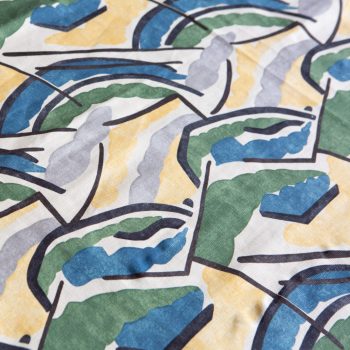Wednesday, March 11
The plan- research my Irish ancestors at the National Archives of Ireland on Bishop Street, a 2 mile walk across the Liffey into a gritty part of Dublin.
 Millennium Bridge, River Liffey, Dublin
Millennium Bridge, River Liffey, Dublin
However, the Archives were closed due to the corona virus. The day was just about shot, so I made my way to Dunne’s Department Store on Henry Street just blocks from my flat. They stocked faux bone cutlery I had admired at my friend’s house and had unsuccessfully searched for in the Paris “marchés.” Once I located my prize, I realized 8 forks, 8 knives, 8 soup spoons, and 8 teaspoons were too heavy to fly home. The clerk recommended sending them through the postal service. This required a trip to the General Post Office (GPO) on O’Connell Street, the republican’s headquarters during the 1916 Easter Rising when they attempted to end 800 years of British occupation. Beginning Easter Monday, April 24th, the leaders of the rebellion took control of the building. By Saturday, April 29th, shelling of the GPO made it uninhabitable. They escaped by breaking through walls of surrounding buildings only to surrender hours later from their new headquarters at 16 Moore Street.
 General Post Office, Dublin, 1916 Easter Rising
General Post Office, Dublin, 1916 Easter Rising
Although it was almost closing, the postal workers were most helpful, the cost was reasonable, my problem was solved.
A downpour forced me home where I lit a fire, took up Angelica Grant’s, Deceived With Kindness: A Bloomsbury Childhood. and had leftovers for dinner. I was about to watch TV when I got a text from my cat sitter. “Because of the Corona Virus, Trump is closing the airports on Friday to international travel. Will you be okay?” No. I wasn’t scheduled to leave for another 10 days.

I’m obsessed with how some Jews knew it was time to leave Germany and other parts of Europe during Hitler’s reign. Would I have had the courage, the sense to get out? Here I was in a somewhat similar dilemma but I hadn’t paid attention. My doctor had asked me to cancel this trip because of the virus. I had had inklings of it’s problems in Paris when France barred Italian trains. But I hadn’t changed my plans. Now I had to get out of Ireland by Friday or be trapped in a foreign country, or so I thought. Immediately, I got on the phone to change my reservation. By midnight I managed to get two flights: one with a stop over in London leaving in 6 hours, another leaving Dublin on Friday getting in at noon. By 3 A.M, I had made a decision. Worried I might get stuck in London, I chose to leave on Friday even though the flight might be delayed: the time difference between Ireland and the states gave me a 5 hour advantage.
Thursday created it’s own problems. When I tried to confirm my flight, United Airlines had an expired passport number. I tried to make the changes on line but to no avail. When I called the airline, I got disconnected after being on hold for three hours. Around midnight, I gave up and checked in using the wrong passport number. I would make the correction at the airport. But if I couldn’t, would I be kept in Ireland indefinitely? This was the second time I wondered if I could get home from Europe. I had been in France on 9/11 and for the few days when the US airports were closed, I imagined never getting home or being shot down mid air.
A cab picked me up at 5 A. M. Friday and for about a half hour provided some distraction. After the driver uncovered I was doing research on my Irish grandmother’s education, he gave me a brief history of hedge schools. During the 18th and part of the 19th century, only those of the Anglican faith were allowed to attend school in Ireland. Hedge schools, usually held in barns, homes and fields were organized to give Catholic children (who were in the majority) an education. Something to mull over in terms of my great- grandmother. On the Irish 1901 census, it indicated she could read and write.
 Rathvilly Hedge School Around 1827
Rathvilly Hedge School Around 1827
Once at the airport, I went to the print out my ticket. I dug in my handbag for my wallet. Nothing. I ran from person to person looking for help. Finally an airport employee used her phone to call the cab company and yes, they had it and, yes, they would drop it off. Relief. But once I went through security, would I be prevented from leaving? My passport indicated I had been in France just 10 days ago, a restriction for entering the United States. I got through. Momentary relief. As I wandered around the airport, I learned that I had to go through United States Preclearance. Now I was really worried. This was US security. What would they do when they realized that I had recently been in France? And the line was exceedingly long. Would I miss my flight?
My worst fears came to nothing. I was back in Princeton by 2 P.M. – enough time to rush to the grocery story and stock up on toilet paper.









 Persepolis
Persepolis










